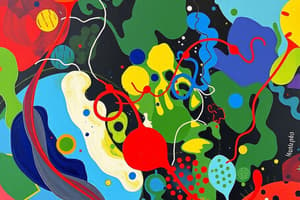Podcast
Questions and Answers
What is the amount of ATP formed when protons and electrons enter the ETC from the FADH2+ coenzyme?
What is the amount of ATP formed when protons and electrons enter the ETC from the FADH2+ coenzyme?
- 2
- 12 (correct)
- 3
- 38
Which complex is involved in the synthesis of ATP in oxidative phosphorylation?
Which complex is involved in the synthesis of ATP in oxidative phosphorylation?
- Creatine kinase
- Dehydrogenase
- Phosphatase
- ATP synthase (correct)
What occurs when tissue respiration and oxidative phosphorylation are uncoupled?
What occurs when tissue respiration and oxidative phosphorylation are uncoupled?
- The formation of ATP decreases and the release of energy in the form of heat increases (correct)
- Both the release of energy in the form of heat and the formation of ATP are reduced
- Both the release of energy in the form of heat and the formation of ATP increase
- The formation of ATP increases and the release of energy in the form of heat decreases
Which compound is an inhibitor of tissue respiration and oxidative phosphorylation?
Which compound is an inhibitor of tissue respiration and oxidative phosphorylation?
What process occurs after the isolation of tissue respiration uncouplers?
What process occurs after the isolation of tissue respiration uncouplers?
What process leads to the disappearance of the electrochemical potential and the termination of ATP synthesis?
What process leads to the disappearance of the electrochemical potential and the termination of ATP synthesis?
Which vitamin is responsible for inactivating an oxidized product, a lipid radical, by electron transfer?
Which vitamin is responsible for inactivating an oxidized product, a lipid radical, by electron transfer?
What is the phenomenon characterized by a sharp increase in oxygen consumption in phagocytic cells?
What is the phenomenon characterized by a sharp increase in oxygen consumption in phagocytic cells?
Which enzyme converts arginine to citrulline in macrophages?
Which enzyme converts arginine to citrulline in macrophages?
What enzyme is involved in the formation of peroxynitrite ONOO- from NO with strong bactericidal properties?
What enzyme is involved in the formation of peroxynitrite ONOO- from NO with strong bactericidal properties?
Which compound is necessary for the conversion of O2 to H2O2 and forms O2- and OH- for bacterial cell destruction?
Which compound is necessary for the conversion of O2 to H2O2 and forms O2- and OH- for bacterial cell destruction?
What particles are involved in protecting the body from bacteria in phagocytic cells?
What particles are involved in protecting the body from bacteria in phagocytic cells?
What feature distinguishes cytochrome oxidase from other enzymes in the electron transport chain?
What feature distinguishes cytochrome oxidase from other enzymes in the electron transport chain?
Which enzyme of the respiratory chain contains cytochromes a and a3?
Which enzyme of the respiratory chain contains cytochromes a and a3?
Which enzyme in the electron transport chain has an active center that includes atoms of iron and copper?
Which enzyme in the electron transport chain has an active center that includes atoms of iron and copper?
What is the final electron acceptor in the respiratory chain?
What is the final electron acceptor in the respiratory chain?
Which enzyme in the electron transport chain does not contain cytochromes?
Which enzyme in the electron transport chain does not contain cytochromes?
Which compound, synthesized from an intermediate product of glycolysis, plays a significant role in regulating oxygen binding to hemoglobin?
Which compound, synthesized from an intermediate product of glycolysis, plays a significant role in regulating oxygen binding to hemoglobin?
Which compound in erythrocytes reduces the affinity of hemoglobin for oxygen by binding to the central cavity of the hemoglobin tetramer?
Which compound in erythrocytes reduces the affinity of hemoglobin for oxygen by binding to the central cavity of the hemoglobin tetramer?
What is the primary regulator of oxygen binding to hemoglobin in tissues, promoting the release of oxygen from hemoglobin?
What is the primary regulator of oxygen binding to hemoglobin in tissues, promoting the release of oxygen from hemoglobin?
How does an increase in the concentration of H+ affect the affinity of hemoglobin for oxygen?
How does an increase in the concentration of H+ affect the affinity of hemoglobin for oxygen?
Which factor enhances the function of releasing oxygen from hemoglobin in tissues?
Which factor enhances the function of releasing oxygen from hemoglobin in tissues?
Which regulator enhances the function of releasing oxygen from hemoglobin in tissues?
Which regulator enhances the function of releasing oxygen from hemoglobin in tissues?
Which amino acid residues in deoxyhemoglobin protomers bind to 2,3 bisphosphoglycerate?
Which amino acid residues in deoxyhemoglobin protomers bind to 2,3 bisphosphoglycerate?
What are the conditions for accelerating the formation of 2,3 bisphosphoglycerate in erythrocytes?
What are the conditions for accelerating the formation of 2,3 bisphosphoglycerate in erythrocytes?
Which compound is the hydrogen atom donor in the reduction of glutathione (GSSG → 2 G-SH)?
Which compound is the hydrogen atom donor in the reduction of glutathione (GSSG → 2 G-SH)?
What is the process occurring in erythrocytes that causes a change in the hemoglobin polypeptide chain with an increase in the content of reactive oxygen species?
What is the process occurring in erythrocytes that causes a change in the hemoglobin polypeptide chain with an increase in the content of reactive oxygen species?
Which enzyme converts 1,3 bisphosphoglycerate to 2,3 bisphosphoglycerate in red blood cells?
Which enzyme converts 1,3 bisphosphoglycerate to 2,3 bisphosphoglycerate in red blood cells?
Flashcards are hidden until you start studying




